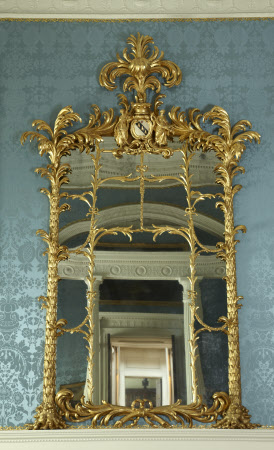Mirror
James Gravenor (fl.1760 - 1770)
Category
Mirrors
Date
circa 1768
Materials
Giltwood, mirror glass, paint
Measurements
458 x 244 cm
Place of origin
England
Order this imageCollection
Kedleston Hall, Derbyshire
NT 108624
Caption
For more than 250 years this impressive giltwood mirror has captured the reflections of the faces of guests at Kedleston Hall in Derbyshire. Made for Nathaniel Curzon, 1st Baron Scarsdale (1726–1804), it hangs within the dressing room of the State Apartments used by his most prestigious guests and must have witnessed very important and glamorous society figures preparing themselves for receptions and dinners. It was made by a cabinetmaker from Derby and probably designed in collaboration with the architect and designer Robert Adam (1728–92). The tropical palm-tree design was also used on a set of matching candle stands and a state bed, creating one of the most impressive and elaborate ‘spare rooms’ in history.
Summary
A giltwood mirror, possibly designed by Robert Adam (1728-92) and executed by carvers James Gravenor (fl. 1741-68) and John Hall, after 1768, when the blue damask which lines the wall it hangs upon was supplied. Topped by a spray of palm leaves atop a leafy arched cresting rail centred by the carved and painted coat of arms and supporters of Curzon, the family’s motto painted just below. The uprights carved as palm trees, with scaly trunks and fibrous roots. The lower rail modelled as ribbon-tied palm fronds. The plate(s) divided by palm leaf-carved beading.
Full description
Health Hazard: presence of tin-mercury amalgam. Made by otherwise obscure carvers believed to be from nearby Derby, this large giltwood mirror with its virtuoso carving forms part of a grand set of furniture commissioned by Nathaniel Curzon. 1st Baron Scarsdale (1726 – 1804) for Kedleston Hall, his newly–built temple to the arts, designed in collaboration with the young and ambitious Robert Adam (1728-92), whose inventive interpretation of Classical architecture created a backdrop of cool, muted interiors for Curzon’s collection of glittering gilded furniture and Old Master paintings. The mirror forms part of the furnishings of the State Apartment on the principal floor of the house, including a bedroom which, although occasionally used for honoured guests, was largely ceremonial in function. The design of this mirror (in the Dressing Room) and its companion pieces, including a pair of smaller mirrors (NT 108626), a pair of torchères (candle stands) (NT 108629) and a State bed (NT 108628), is inspired by the palm tree; fibrous roots, scaly trunk and elongated fronds with their tropical luxuriance being interpreted in carved wood for the furniture’s structural elements and decorative flourishes. The mirror is topped by a carved coronet and the coat of arms of 1st Baron Scarsdale - Curzon being elevated to the title in 1761 - flanked by carved and gilded figures of Prudence with her javelin and Liberality holding a cornucopia and with the family motto, RECTE ET SUAVITER, meaning ‘justly and mildly’ painted below. The palm, an important symbol variously of fame, victory, peace and eternal life in both Classical and Judeo-Christian art, would have been a familiar motif for Curzon and especially Robert Adam who may have had a hand in the design of the mirror. The palm appears in architectural works, such as Juan Bautista Villalpando’s (1552-1608) 1604 engraving of the sanctuary of Solomon’s Temple, as described in the Bible, with its palm tree pillars, along with architect John Webb’s (1611-1672) design for the Royal Bedchamber at Greenwich Palace of 1665 which similarly incorporated columns designed as palm trees. Most influential perhaps would have been the splendid Palm Room at Spencer House designed by John Vardy (1718 -1765) in 1757, a few years earlier than this mirror.
Provenance
Nathaniel Curzon, 1st Baron Scarsdale and by descent to Francis Curzon, 3rd Viscount Scarsdale (1924-2000). Purchased in 1987 by the National Heritage Memorial Fund and loaned to the National Trust from 1987-1988. Purchased by the National Trust in 1988 from the National Heritage Memorial Fund.
Marks and inscriptions
Beneath cresting: Arms, supporters, coronet and motto RECTE ET SUAVITER [Justly and Mildly] of Lord Scarsdale
Makers and roles
James Gravenor (fl.1760 - 1770), carver Sir John Hall, carver possibly Robert Adam (Kirkcaldy 1728 - London 1792), designer
References
Antram & Jackson-Stops, 1988: Nicholas Antram and Gervase Jackson-Stops, Kedleston Hall, National Trust p 38. Saumarez Smith, 1993: Charles Saumarez Smith, Eighteenth Century Decoration Design and the Domestic Interior, p.29. McCormack, 2017-18: Simon McCormack, Elegance & Grandeur Reinstated, Arts Buildings Collections Bulletin, National Trust, Winter 2017-18, pp.6-9. Knox, 2017: Tim Knox, Silken splendours secured for the nation, Country Life, May 31, 2017, pp.174-180

